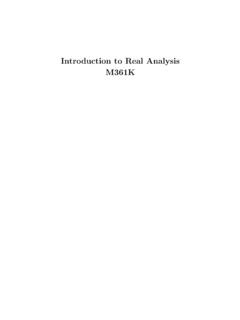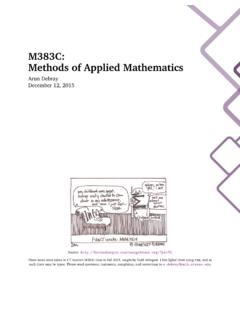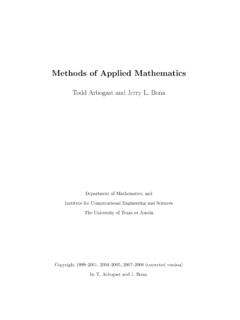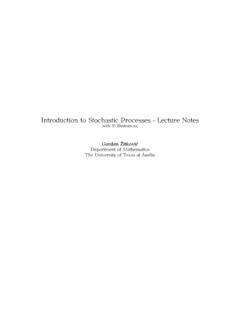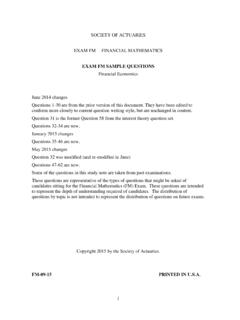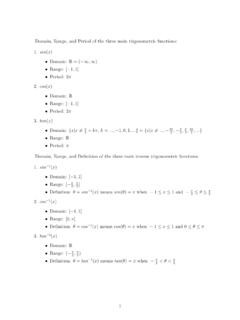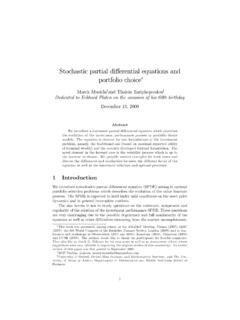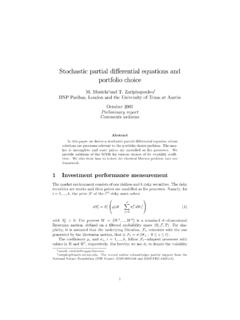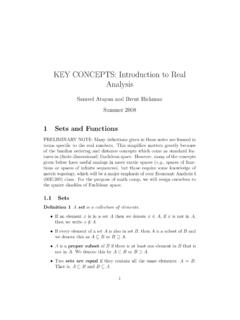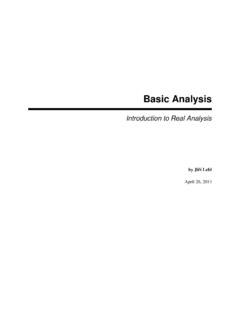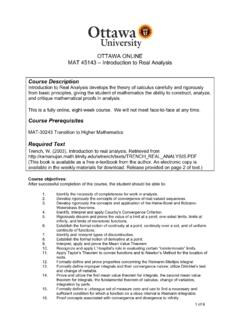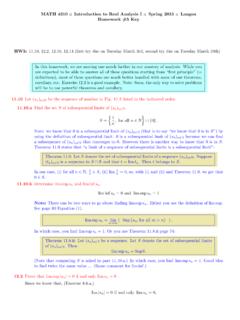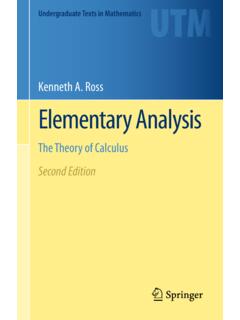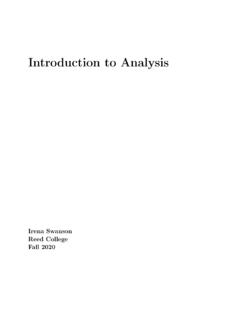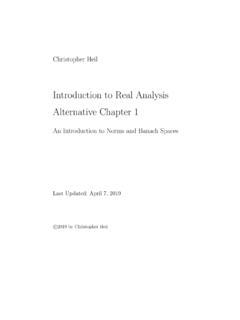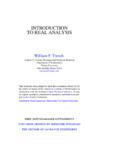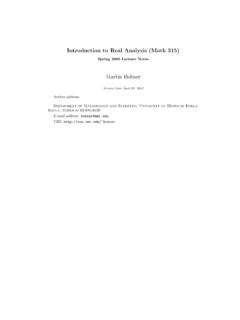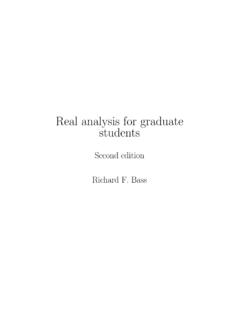Transcription of Introduction to Real Analysis M361K - web.ma.utexas.edu
1 Introduction to real AnalysisM361 KLast Updated: July 2011 PrefaceThese notes are for the basic real Analysis class, M361K (Themoreadvanced class is M365C.) They were written, used, revised and revisedagain and again over the past decade. Contributors to the text includeboth TA s and instructors: Grant Lakeland, Cody Patterson,AlistairWindsor, Tim Blass, David Paige, Louiza Fouli, Cristina Caputo andTed subject is calculus on the real line, done rigorously. The maintopics are sequences, limits, continuity, the derivative and the Riemannintegral. It is a challenge to choose the proper amount of preliminarymaterial before starting with the main topics. In early editions wehad too much and decided to move some things into an appendix toChapter 2 (at the end of the notes) and to let the instructor choosewhat to cover. We also removed much of the topology onRmaterialfrom Chapter 3 and put it in an appendix.
2 In a one semester coursewe are usually able to do the majority of problems from Chapter 3 6and a small selection of certain preliminary problems from Chapter 2and the two 2011 ContentsChapter 1. Introduction11. Goals12. Proofs13. Logic2 Chapter 2. Preliminaries: Numbers and Functions51. Functions82. The Absolute Value133. Intervals15 Chapter 3. Sequences191. Limits and the Archimedean Property192. Properties of Convergence253. Monotone Sequences284. Subsequences335. Cauchy Sequences346. Decimals357. Supremums and Completeness398. real and Rational Exponents43 Chapter 4. Limits of Functions and Continuity471. Limits of Functions472. Continuous Functions553. Theorems About Continuous Functions594. Uniform Continuity62 Chapter 5. Differentiation651. Derivatives652. Theorems About Differentiable Functions68 Chapter 6. Integration711. The Definition712. Integrable Functions773.
3 Properties of Integrals784. Fundamental Theorems of Calculus805. Integration Rules81iiiivCONTENTSA ppendix A. Prerequisite Knowledge831. Set Theory832. The Field Properties of the real Numbers853. The Order Properties of the real Numbers884. The Ordered Field Properties of the real Numbers905. Mathematical Induction91 Appendix B. Appendix to Chapter 3931. Cardinality932. Open and Closed Sets963. Compactness994. Sequential Limits and Closed Sets100 CHAPTER 1 Introduction1. GoalsThe purpose of this course is three-fold:(1) to provide an Introduction to the basic definitions and theo-rems of calculus and real Analysis .(2) to provide an Introduction to writing and discovering proofsof mathematical theorems. These proofs will go beyond themechanical proofs found in your Discrete Mathematics course.(3) and most importantly to let you experience the joy of mathe-matics: the joy of personal ProofsHopefully all of you have seen some proofs before.
4 A proof is thename that mathematicians give to an explanation that leavesno level of detail in this explanation depends on the audience for theproof. Mathematicians often skip steps in proofs and rely onthe readerto fill in the missing steps. This can have the advantage of focusingthe reader on the new or crucial ideas in the proof but can easilylead to frustration if the reader is unable to fill in the missing seriously these missing steps can easily conceal mistakes: manymistakes in proofs, particularly at the undergraduate level, begin with it is obvious that .In this course we will try to avoid missing any steps in our statement should follow from a previous one by a simple prop-erty of arithmetic, by a definition, or by a previous theorem,and thisjustification should be clearly stated in plain language. Writing clearproofs is a skill in itself. Often the shortest proof is not the is no mechanical process to produce a proof but there aresome basic guidelines you should follow.
5 The most basic is that everyobject that appears should be defined; when a variable, function, or setappears we should be able to look back and find a statement definingthat object:(1) Let >0 be Introduction (2) Letf(x) = 2x+ 1.(3) LetA={x R:x13 27x12+ 16x2 4 = 0}.(4) By the definition of continuity there exists a >0 such watch out for hidden assumptions. In a proof, you may want tosay Letx Abe arbitrary, but this does not work ifA= (where denotes the empty set). A common error in real Analysis is to writelimn anor limx af(x) without first checking whether the limit exists (oftenthe hardest part).A key factor in determining how a proof should be written is theintended audience. For this course, your intended audienceis anotherstudent in the class who is clueless as to how to prove the theorem, butwho knows all the definition and the results of the course covered upto that LogicFor the most part, we will avoid using overly technical logical nota-tion in our definitions and statements.
6 Instead we will use their plainEnglish equivalents and we suggest you do the same in your switching to the contrapositive and negating a definition, for-mal logical manipulation is rarely helpful in proving statements in the other hand, you should be familiar with the basic logicaloperators and we will give a short review here. IfPandQarepropo-sitions, , statements that are either true or false, then you shouldunderstand what is meant by(1) notP(2)PorQ(the mathematical use of or is not exclusive so that PorQ is considered true if bothPandQare true).(3)PandQ(4) ifPthenQ(or PimpliesQ )(5)Pif and only ifQ(sometimes writtenPis equivalent toQ)Similarly ifP(x) is apredicate, that is a statement that becomes aproposition when an object such as a real number is inserted forx,then you should understand(1) for allx,P(x) is true(2) there exists anxsuch thatP(x) is trueSimple examples of such aP(x) are x >0 or x2is an integer.
7 These statements are true for some values ofxand not for should also be familiar with the formulae for negating the var-ious operators and LOGIC3 Most of our theorems will have the form of implications: ifPthenQ. Pis called the implication ifPthenQ isthe implication if notQthen notP. The contrapositive is logically equivalent to the means that one is valid (true) if and only if the other is it is easier or better to pass to the contrapositive formulationwhen proving a the implication ifPthenQis the im-plication converse isnotlogically equivalent to the original implicationand this fact is the underlying source of error in many statement that is always true is called atautology. Astatement that is always false is called show that an argument is not valid it suffices to find one situationin which the hypotheses are true but the conclusion is typeof situation is called technique of proof is by contradiction.
8 To prove PimpliesQ we might assume thatPis true andQis false and obtain a contradic-tion. Whenever you use contradiction, it is usually a good idea to see ifyou can rephrase your proof in a way that does not use times, contradiction is not necessary and avoiding its use canlead to cleaner (and more understandable) will notice that we mostly spoke in great generality in thepreceding review. If at any point you found yourself confused in regardsto the meaning of a definition or the purpose of a concept, you shouldcreate some examples of the situation being described. Be asconcreteas you can. In fact, as we will emphasize later, you should usethisstrategy any time you are confused when reading these notes (or anymathematics textbook).CHAPTER 2 Preliminaries: Numbers and FunctionsWhat exactly is a number?If you think about it, to give a precise answer to this question issurprisingly difficult.
9 As is often the case, the word number reflects aconcept of which we have some intuitive understanding, but no concretedefinition. In this Introduction , we will attempt to pin downwhat wemean by a number by describing exactly what we should expect from anumber system. In fact, though we will not prove it, the only collectionthat satisfies are of our demands isR, the collection ofreal we conclude that a number is an element of the setR. Just aswith numbers, most of us have probably heard the term real numbers, but may not be exactly sure what they are. Studying real numbers willbe one of the important purposes of this mentioned above, we all know the things that we should expectfrom a number system. Think back to when you first met the idea of anumber. Probably the very first purpose of numbers in your life is thatthey allowed you to count things: 50 states, 32 professionalfootballteams, 7 continents, 5 golden rings, etc.
10 Needing to count things leadsus to the invention (or discovery depending on your point of view) ofthe natural numbers (the numbers 1,2,3,4,5, ). Mathematicianstypically denote the collection of natural numbers by the symbol N. Though this collection can be constructed quite rigorouslyfrom thestandard axioms of mathematics, we will assume that we are all famil-iar with the natural numbers and their basic properties (such as theconcept of mathematical induction; see the appendices). The naturalnumbers fulfill quite successfully our goal of being able to next thing that we expect of our number system is that itshould be able to answer questions like the following: If the Big Twelvehas 10 football teams and the Big Ten has 12 (shockingly it s true), howmany teams do the conferences have between them? In other wordswe will need to add. We will also multiply. The natural numbers arealready well-suited for these tasks.
